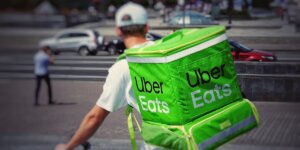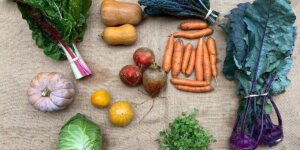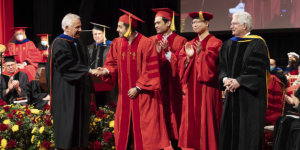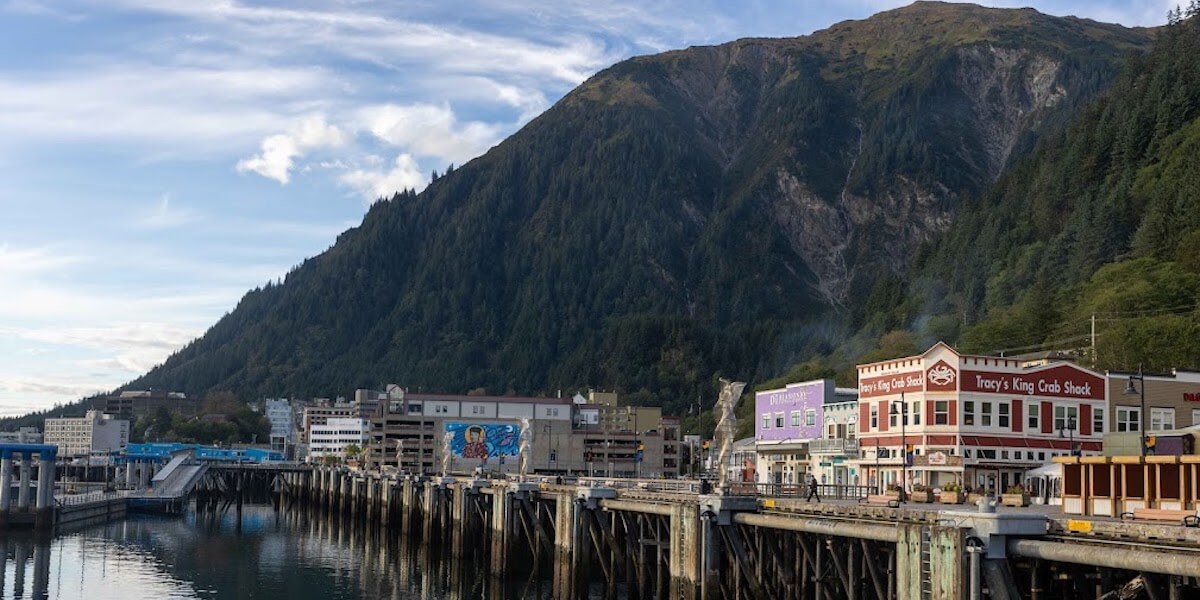
Alaskan shoreline, in Juneau, AK. PHOTO/Jean-Daniel LeRoy.
In Los Angeles, an empty fridge could be an easy fix: a trip to the nearest grocery store, where you can stock up on fresh fruits and vegetables, milk and whatever else your heart desires, without going bankrupt.
In Hoonah, Alaska, it’s not quite that simple. Fresh produce is not so easy to acquire — eating an orange that hasn’t already gone bad (even one that costs $4 – $10) is considered not just a luxury, but an anomaly — and stocking up at Costco, which is a three-hour ferry ride away in Juneau, is often the best way to get groceries.
Food security is just one of the problems that the largely Tlingit indigenous community in Hoonah, an island in Alaska’s southeast panhandle, grapples with on a regular basis, and is one of the key issues that 27 students from the USC Viterbi School of Engineering’s CE 486a “Innovation and Engineering and Design for Global Crises” experienced firsthand during a September visit to the island.
The course, led by three Sonny Astani Department of Civil and Environmental Engineering faculty, including David Gerber, associate professor of practice, and part-time lecturers Brad Cracchiola and Daniel Druhora, exposes students directly to communities dealing with a formidable and specific set of challenges and asks them to develop creative, sustainable and implementable solutions. This year’s choice of Hoonah and its indigenous community of just under 750 people is coupled with global considerations of sustainability, rising cost of living and infrastructure to support isolation.
The innovative course, which was previously featured in the PBS documentary, “Lives, Not Grades,” has now pivoted from solving challenges in Europe’s largest refugee camp to challenges a bit closer to home—a move inspired by CEE Chair Burcin Becerik-Gerber who, amid the pandemic, welcomed a shift to local/ national issues. In Hoonah, she said there are several challenges that engineering solutions could be developed for: climate change, sustainability and energy, education, poverty and health.
The course stresses the importance of immersion among communities and the issues they might be dealing with versus observing from afar. Said Gerber: “Embedding in communities and ecologies is a key means for us to more deeply understand our problem space. Working with versus working for is a key aspect of our method to help our students innovate impactful design and engineered solutions.”
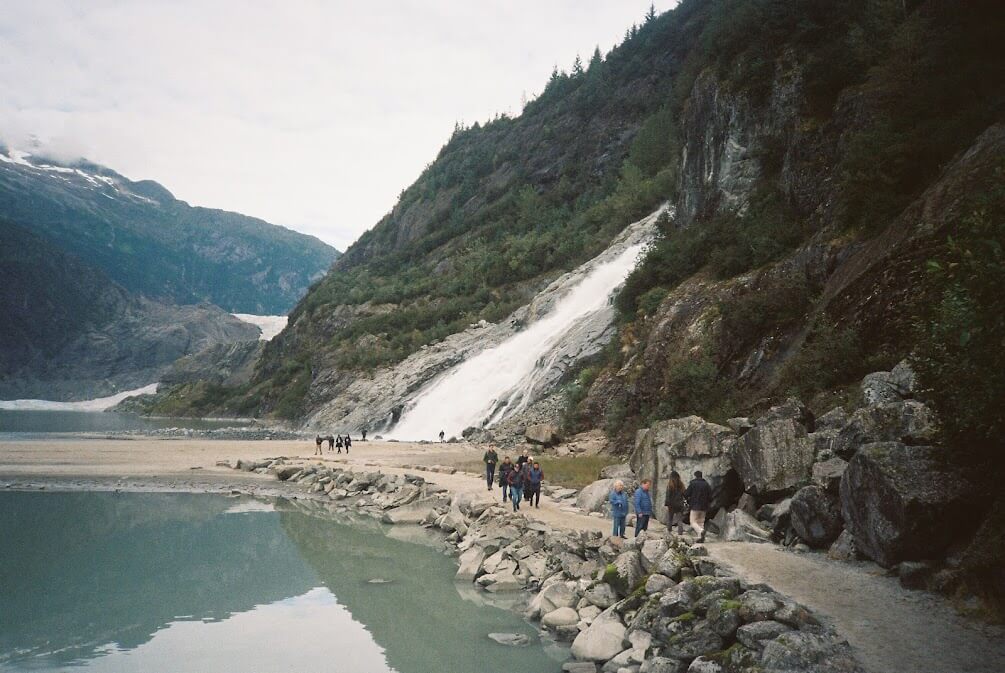
Exploring Hoonah. PHOTO/JEAN-DANIEL LEROY.
Said Kelly Sanders, a USC Viterbi associate professor of civil and environmental engineering, who serves an advisor for the course: “This is a really unique community, because it’s a very isolated and small population and it deals with a lot of unique challenges — challenges that someone living in a metropolitan area in the lower 48 states would not encounter.”
Sanders, the Dr. Teh Fu Yen Early Career Chair, said it was clear sustainability would be a critical lens through which to look at these challenges. Among the most cited challenges identified by the students and faculty, based on conversations with the residents, was the cost of electricity.
“The residents on the island are paying as much as three times what we pay in Los Angeles, and Los Angeles is about double the national electricity cost average, so these residents are paying six times the national average,” Sanders said. “This becomes really challenging for residents of Hoonah when you consider their severe winters, when they are very dependent on diesel fuel.”
Even though Alaska is an oil producing state, it produces raw oil and sends it back to the lower 48 states to get it refined and then buys it back. “You can imagine this becomes a really, really expensive way to provide energy services,” Sanders said.
Meanwhile, Sanders said food on the island is prohibitively expensive. “A gallon of milk, for example, can cost $10,” she said. “They are really dependent on ships and planes to bring in their food supply, as well, and if those planes and ships get delayed due to weather or other issues, there might not be the food supply you need to ensure food security.”
The problems faced by this community are issues many of us take for granted as a reliable aspect of our day-to-day realities. Between issues of access and cost, easy things become a lot more all-consuming, especially with limited resources, including labor.
The students will work in six teams to develop innovative solutions that can address some of the community’s most pressing concerns. Prototypes will be tested on a second trip to Hoonah in March, fine-tuned and then presented later in the spring to a panel of professors and peers.

From left to right: Alexander Balasky, Michael Cesar, Joshua Jacobs, Ben Brooks, Kelly Sanders, and Ilan Tenenbaum. PHOTO/JEAN-DANIEL LEROY.
A Sustainable Lifestyle
In many ways, the communities in Hoonah rely on a basic sense of camaraderie and mutual benefit. Families will go in together for a single trip to Costco, or a moose hunted in the wild will be split among many different families, Sanders said.
They also are aware of energy conservation strategies as a means of making monthly budgets, because they cannot afford to be passive or absent minded about such matters.
Said USC student, Serena Allen, who studies public policy: “In Hoonah, people have a real ‘get it done’ energy. Even 12 or 13-year-olds seemed aware of how much energy costs and most work at least a small job to help out.”
Students were able to have conversations with locals, as well as engage with presentations from the city manager and a conversation with an elder from the community, who shared his struggle with substance abuse, among other stories.
While energy and food security were top of mind, students looked further to identify potential areas of focus for their innovations.
USC Viterbi senior, Kali Lee, who is studying civil engineering with an environmental engineering emphasis, said that with such a small, isolated population, Hoonah’s residents fill many roles.
“We met one person, Jeff, who ran the Salvation Army on the island, was the pastor on the island, and was also the electrician and plumber on the island,” said Lee. “They don’t have the resources for each person to specialize, or to have multiple people in the same role. That’s a really big thing looking forward. We can’t fix issues like energy costs or food supply in a year, but I’m thinking more about how we can set up these communities so they can continue to sustain themselves with the knowledge and skills to progress as well.”
One area Lee was particularly taken with was a conversation with Duff Mitchell, CEO of Juneau Hydro, a hydroelectric facility project aimed at increasing energy security in the area. Instead of environmental engineering, he referred to his work as ecological engineering — harmonizing with the environment — and looked at structures like dams from the perspective of how they can be used to improve the environment instead of manage or harm it.
“It’s such an important thing to Alaskans,” Lee said. “They are really concerned with how they can improve the environment for the fish, for example. It is a much more holistic perspective.”
Said USC Viterbi student, Josh Weadick, who is studying computer science: “A big problem is government policy and navigating bureaucracies, like energy companies. A lot of the discussion we had, like with the city manager, emphasized that, more than a lack of infrastructure to fix these problems, there are a lot of competing factors that make them more complicated.”
Motivation to Apply
The problem of sustainability is quite obviously a large and all-encompassing issue that will continue growing in urgency. Students like Weadick said that this is a big part of why the course called to them.
“I want to work on sustainability issues in my career and help find solutions to big problems that are affecting everyone, but especially impacting indigenous and minority communities who have been so overlooked in the past,” he said. “Often these groups aren’t asked for their feedback or opinions and so this is a really big area of focus I want to go into. I’ve been dying to use what I’ve learned at USC to help people in a tangible, practical way.”
“The people of Hoonah have such a respect and love for nature—and they are so connected to it,” Lee said. “It’s such an underdeveloped area and I was really drawn to it and the problem of environmental sustainability.”
Published on December 2nd, 2021
Last updated on December 7th, 2021




